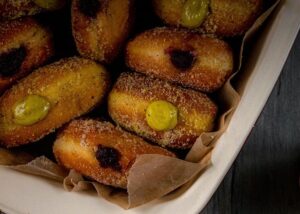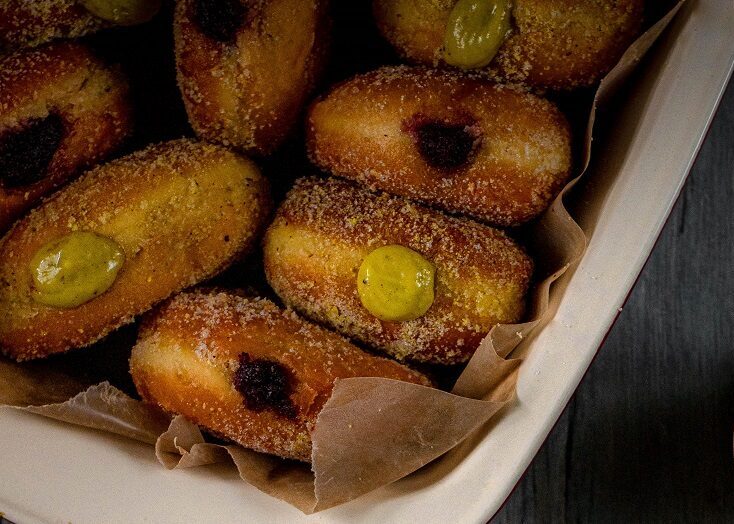Ingredients
Equipment
Method
For Krafne Dough
- In a small bowl, add the lukewarm milk, yeast and sugar and set aside for 10-15 minutes, until the yeast bubbles and grows.
- Note: I did this by hand as my mother did, but you can bring the dough together in a mixer. Just make sure to use a paddle to bring the ingredients together and not a dough hook. I find making this dough by hand with a good strong wooden spoon and a good large mixing bowl works best and it takes no time at all. Later note: the mixer is working well when I use the batter mixer then the hook as stated here.
- Either way, cream the softened butter and sugar first.
- Whisk in the egg yolks, making sure each yolk gets mixed into the dough before adding the next. Returning to the wooden spoon, add the Croatian Sljivovica or other brandy/rum, the lemon zest and salt and mix together.
- Add in one large spoonful of flour, along with the yeast mixture. Combine until fully incorporated. Slowly alternate adding spoonfuls of flour and about 1/3 of the milk. Watch the dough as you do this; make sure you are fully incorporating each ingredient before adding the next. You might use all of the flour, or not, but you will know the dough is ready, once it pulls away from the sides of the bowl and the spoon. If you want to emulate my family, start vigorously beating the dough from beneath with the wooden spoon--check my Instagram story highlights for a short video instruction of this process. Perhaps only for a minute or two, doing this ensures a night, light, airy dough.
- Drop the dough into a bowl with a little flour. Cover with a dish towel and let proof for a full hour. I place the covered bowl into a 200 degree oven after it is shut off, and I use that invaluable wooden spoon to prop open the oven door slightly.
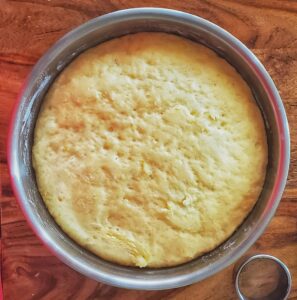
- Roll out the Krafne dough on a lightly floured surface until it is about ¾ inch thick. Cut out the desired size of Krafne. I finally purchased ring molds, but I used a mug or glass that has been dipped in flour for years. Keep making doughnuts with the remaining dough until you cannot make doughnuts any more, but try to make the most you can before further manipulating the dough. Do not re-roll the dough more than you have to. Sometimes overworking it causes folds, which cause the fried doughnuts to split when filling. Be ginger:)
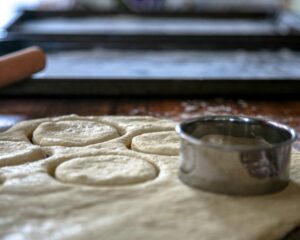
- Drop the cut out Krafne on a floured baking sheet or two and cover with more dish towels to proof for an additional 20-30 minutes.
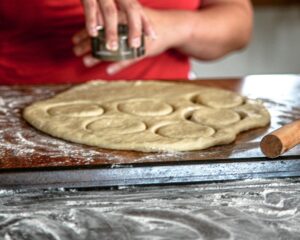
- Heat your Canola or Vegetable oil in a deep, preferably ceramic pot. Make sure to have about two inches of oil and let the oil heat to about 325 - 350 degrees, depending on your stove/pot. Test a small doughnut to make sure it rises to the surface.
- Fry 4-6 Krafne at once, depending on their size. They will grow golden very quickly and you can then flip them over. If getting too dark too quickly, lower the heat slightly. The Krafne should also puff up a fair amount. See notes as to the best way to drop in the doughnuts.
- Once both sides are golden brown, other than the recognizable pale ring around the middle, remove and drain on a baking sheet or shallow dish with paper towels. I like to roll immediately in granulated sugar, but you can wait and use confectioners sugar if preferred.

- Once the Krafne have cooled for at least 10 minutes, you can fill with Nutella, fruit preserve, pastry cream, or other fillings. The recipe for Apricot Cream Filling and additional notes on filling the Krafne can be found above in the bullet points. They keep decently for the day or the next morning, but, of course, you cannot beat fresh, warm Croatian Krafne doughnuts on a winter night, a spring morning, a summer day, a fall evening, you get the drift, no?:)
